Designating the Primary Mail System
The administrative information that you assign drives both the Email pagelet and Calendar Events pagelet. The portal supports Lotus Notes/Domino, Microsoft Outlook Web Access/Exchange, POP3, and IMAP systems for email, and Lotus and Microsoft for calendars. Remember that only one email and calendar system is designated as the portal's default system. The default system is considered primary and is the first email section on a user's pagelet. It is possible to override the system default for an individual user.
This topic discusses how to configure the Primary Email System.
Note: For the pagelets to be fully functional, you must complete setup procedures for the application and mail servers.
|
Page Name |
Definition Name |
Usage |
|---|---|---|
|
EO_PE_ADMIN |
Designate the primary email and calendar system for the portal. |
|
|
EO_PE_ADMIN_OPR |
Add overriding email and calendar settings for an individual user ID. |
The Portal Administrator designates the primary email and calendar system.
Use the Email and Calendar Defaults page (EO_PE_ADMIN) to designate the primary email and calendar system for the portal.
Navigation:
This example illustrates the fields and controls on the Email and Calendar Defaults page. You can find definitions for the fields and controls later on this page.
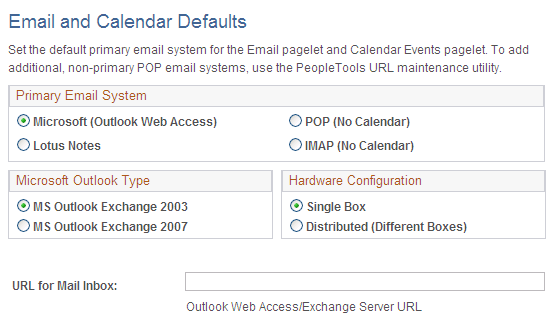
Note: The fields shown on this page vary depending on which email system is selected as the primary email system.
Field or Control |
Description |
|---|---|
Primary E-mail System |
Select the default email/calendar system for the portal. Additional fields display based on your selection. Available options are:
|
This sections discusses the configuration for Microsoft Outlook Web Access.
This example illustrates the fields and controls on the Email and Calendar Defaults page. You can find definitions for the fields and controls later on this page.
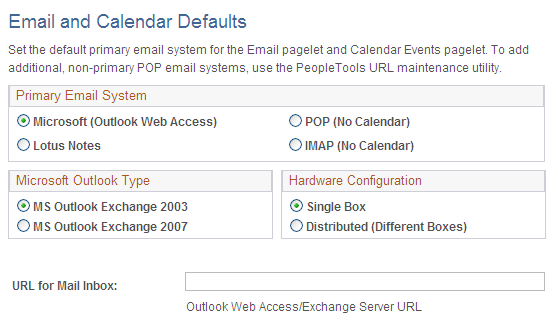
Access the Email and Calendar Defaults page and select the Microsoft (Outlook Web Access) option.
Field or Control |
Description |
|---|---|
Microsoft Outlook Type |
This field applies when you select the Microsoft (Outlook Web Access) option in the Primary E-mail System group box.
|
Hardware Configuration |
These fields display when you select the Microsoft (Outlook Web Access) option in the Primary E-mail System group box.
|
URL for Mail Inbox |
For Microsoft, enter the URL typically used for Outlook Web Access/Exchange Server URL. The URL should have the form:
Use the folder name exchange. The exchange name is the mapped folder name in the IIS installation. It maps to the physical folder in which Exchange is installed. Always use exchange as the folder name in the URL for Mail Inbox field. |
This sections discusses the configuration for Lotus Notes.
This example illustrates the fields and controls on the Email and Calendar Defaults page. You can find definitions for the fields and controls later on this page.
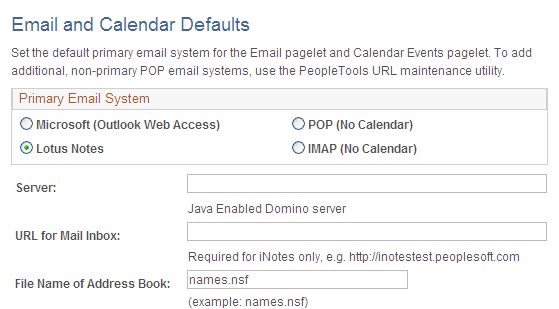
Access the Email and Calendar Defaults page and select the Lotus Notes option.
Field or Control |
Description |
|---|---|
Server |
This field displays when the Lotus Notes option is selected in the Primary E-mail System group box. Enter the server name. For Lotus Notes, enter the name of a Domino server on the network. Typically, this is a centralized hub server. This is the Domino server enabled with additional services and has the custom view PS_PORTAL_MAIL_LOCATION in the Name and Address Book. |
URL for Mail Inbox |
Enter a URL (the link on the pagelet transfers the user to this location in a new browser window). For Lotus, this field is relevant only for web-enabled iNotes mail. |
File Name of Address Book |
This field displays when the Lotus Notes option is selected in the Primary E-mail System group box. Enter the file name for the Lotus Notes name and address book. |
This sections discusses the configuration for POP.
This example illustrates the fields and controls on the Email and Calendar Defaults page. You can find definitions for the fields and controls later on this page.
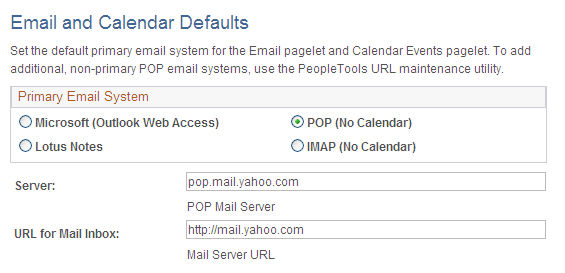
Access the Email and Calendar Defaults page and select the POP (No Calendar) option.
Field or Control |
Description |
|---|---|
Server |
Enter the POP mail server name. For example, for Yahoo!, enter pop.mail.yahoo.com. |
URL for Mail Inbox |
Enter the mail server URL (the link on the pagelet transfers the user to this location in a new browser window). |
This sections discusses the email configuration for IMAP.
This example illustrates the fields and controls on the Email and Calendar Defaults page. You can find definitions for the fields and controls later on this page.
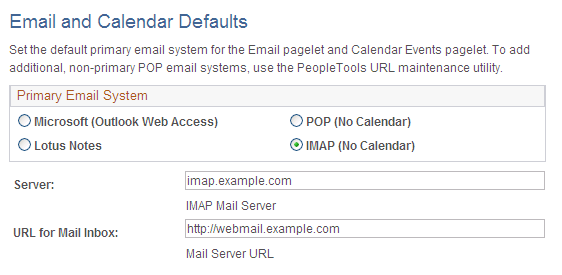
Access the Email and Calendar Defaults page and select the IMAP (No Calendar) option.
Field or Control |
Description |
|---|---|
Server |
Enter the IMAP mail server name. |
URL for Mail Inbox |
Enter the mail server URL (the link on the pagelet transfers the user to this location in a new browser window). |
Use the Email and Calendar by User page (EO_PE_ADMIN_OPR) to add overriding email and calendar settings for an individual user ID.
Navigation:
This example illustrates the fields and controls on the Email and Calendar by User page.
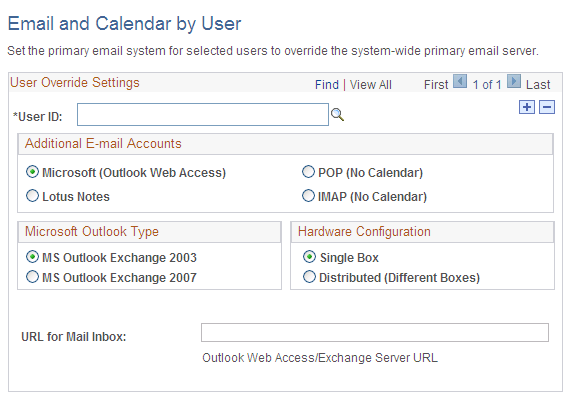
Select the user ID for which you want to define overriding email and calendar information. The remaining fields function like those on the Primary E-mail and Calendar Defaults page. Entries on this page override the primary email system settings entered on that page for the specified user.
If your web server is SSL-enabled, in addition to specifying an HTTPS URL on the E-mail and Calendar Defaults page, you must do the following:
For Microsoft Exchange, in the ASP file change the strProtocol value to https, or change the isFormBasedAuth flag to true, or both.
For POP/IMAP, specify the SSL port number in the mail server URL.
No extra steps are required for Domino.